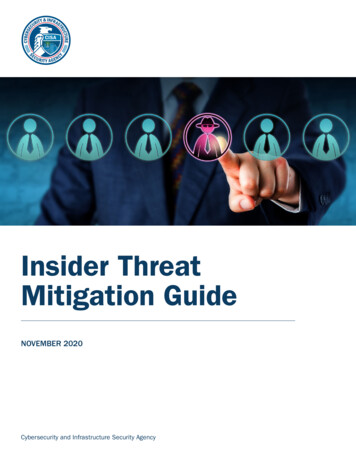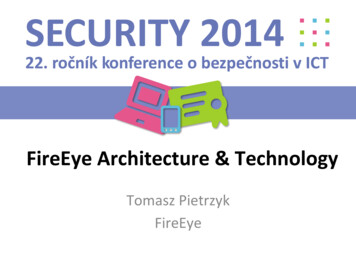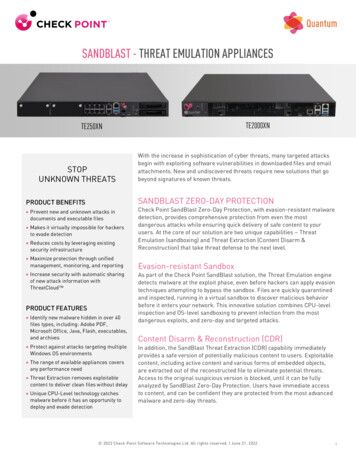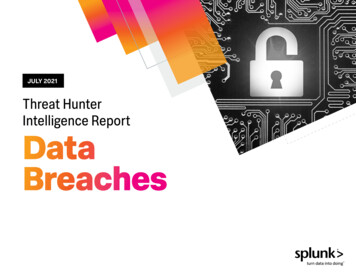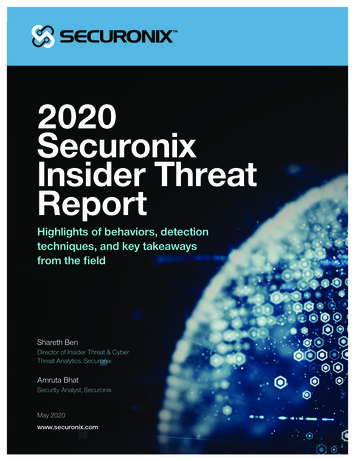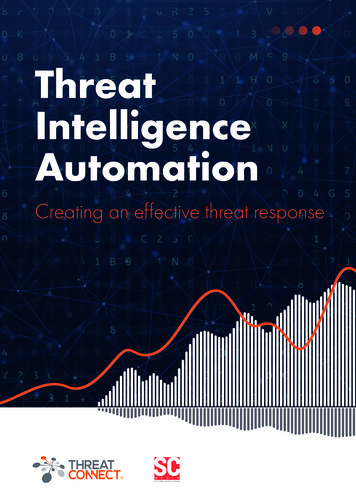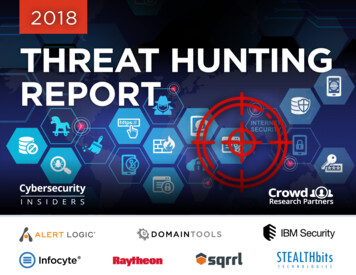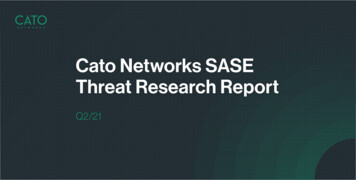
Transcription
Cato Networks SASEThreat Research ReportQ2/21
Executive SummaryThe latest Cato Networks SASE Threat Research Reporthighlights cyber threats and trends based on more than 250billion network flows that passed through Cato Cloud duringQ2, 2021. The convergence of networking and securityprovides unique visibility into both enterprise network usageas well as the hostile network scans, exploitation attempts,malware communication to C&C servers, and othermalicious activity occurring across enterprise networks.Key Quarterly Findings:1/Consumer devices and consumer facing threats find their2/Malware authors find new ways to exfiltrate data from infected3/Significant increase in non-work-related app usage onThe report offers insight and a behind-the-scenes look intohow Cato Networks analyzes and identifies new threats. Italso highlights important breach reports and cybersecuritynews from the past quarter.way into corporate networks.devices, undetected when running multiple point solutions.organizations’ networks.Cato SASE. Ready for Whatever’s NextQuarterly Report 21Q22
Section 1The DataCato SASE. Ready for Whatever’s NextQuarterly Report 21Q23
NetworkThis quarter has seen a rise of almost 40% in the number of network flows, increasing from 190B in Q1 to 263B inQ2. This was also reflected in the number of verified security threats that grew from 19K in Q1 to 29K in Q2.Network Flows 263BAny sequence of packets sharing a common sourceIP and port, destination IP and port and protocolEvents 22BAny network flow that is triggered by one of CatoNetworks’ security controlsCato Threat Hunting SystemCato Networks automated threat hunting system identifies high risk events using proprietarymachine learning models and based on multiple network and security indicatorsThreats 151KHigh-risk flows based on machine learning anddata correlationIncidents 29KA verified security threatCato SASE. Ready for Whatever’s NextQuarterly Report 21Q24
Top 5 Threat TypesThe top threat types observed in Q2 had the most significant change from any of the other data points in this report compared to Q1 numbers. Malware attacksmade a significant jump as did the overall number of attacks. A new category, policy violation, is introduced this quarter and moved directly to fourth place.Network Scan 9,689,679,794An event triggered by a network discovery scan (SYN scan, port scanning etc.)Malware 816,872,308An event triggered by a malwareReputation 475,282,590An event triggered by inbound or outbound communication to destinations(domains, IPs, and more) known to have bad reputationPolicy Violation* 395,674,855An event that violate either the Cato security policy or common best practices for network securityVulnerability Scan 241,642,211An event triggered by a known vulnerability scanner (such as OpenVAS, Nessus and others)Worth Noting108,395,089Remote Code Execution1,225,829Privilege Escalation840,218Crypto MiningCato SASE. Ready for Whatever’s NextQuarterly Report 21Q25
Top 5 Attack Origin CountriesUSAJapanGermanyChinaVenezuelaThis map shows the top five countries from which maliciousactivity was initiated. Most of the malicious activity is relatedto malware C&C communication, thus this map shows thecountries hosting the most C&C servers.This quarter sees much of the same countries as observed inQ1, the only change being Germany and Japan swapping fourthand fifth places. Sixth to eighth places also remained the same,namely Singapore, Netherlands and the UK with Ireland andUnderstanding where attacks originate from or where malwarecommunicates to is a crucial part of any organization’s visibilityto threats and trends. Attackers know that some outboundcommunication to certain countries may be blocked or inspectedand accordingly – they make sure their C&C (command andcontrol) infrastructure is hosted in what may be perceived as“safe” countries.India completing the top 10 and pushing out South Korea.Cato SASE. Ready for Whatever’s NextQuarterly Report 21Q26
Top 5 Most Used Cloud Apps1 Microsoft Office2 Google Apps3 Skype4 TeamViewer5 FacebookThe top five applications for Q2 are almost the same as Q1 except for Facebook, which rose tofifth place. While enterprise-oriented cloud applications are to be expected at the top of the list it isinteresting to see the sharp increase in usage of consumer applications, such as TikTok (4x in thenumber of flows compared to Q1), Facebook (4x), YouTube (3x) and Amazon Video (3.5x).During Q2, Amazon announced the launch of Amazon Sidewalk - a new feature that constructs ashared network between Amazon Echo devices, Ring Security Cams, outdoor lights, and more. CatoResearch Labs has identified hundreds of thousands of Sidewalk enterprise networks, with someenterprises having hundreds of such devices. This does not only raise a network issue (Is this reallyhow an organization wants its infrastructure to be used?) and a security issue (Does an organizationwant to take the risk of unpatched, unsecure devices – not just their employees’ devices but also theiremployees’ neighbors’ device—connecting to their networks?) but also points to a lack of visibility intowhat is truly connected and affecting the organization’s network.*Cloud apps are identified based on domains, IPs, and traffic inspection.Cato SASE. Ready for Whatever’s NextQuarterly Report 21Q27
Top 5 CVE Exploit AttemptsWorth NotingWhile older Microsoft vulnerabilities account for many of the top 15 spots (includingMS JET, Windows DNS server and others), consumer facing CVEs are there aswell such as CVE-2018-10562 which targets Dasan GPON home routers (similarin nature to the Mirai scanning). With the continuous dissolvement between the“home” and “organization” 15,703CVE-2017-9841In Q1 CVE-2017-9841 (a PHP RCE) held the number one spot. This quarter, despite an increase in the number ofattempts using CVE-2017-9841 from 377k to 515k, it fell to the fifth spot following a slew of more recent CVEs.Completely dominating the number one spot is 2020 CVE, a WordPress wp-hotel-booking vulnerability. Secondis 2021-28482 – the Microsoft Exchange vulnerability published mid-April this year. The third and fourth entrieson the list are also Microsoft vulnerabilities released mid-April and they are the TCP and SMB vulnerabilities.Cato SASE. Ready for Whatever’s NextQuarterly Report 21Q28
Section 2On the HuntMalware authors are at a constant battle with security researchers, always looking for and producing new ways to avoid detection.This “cat and mouse” game is not limited to just avoiding detection by anti-virus/anti-malware systems but continues well into theattack life cycle. Evading anomaly detection, device ID identification and data exfiltration are just some of the areas in which malwaredevelopers have invested time and effort over the years.Cato Research Labs has recently analyzed an old threat that has resurfaced – the Houdini malware. Houdini is a RAT (Remote AccessTrojan / Remote Administration Tool) malware which is extremely popular with MENA (Middle East / North Africa) threat actors. Themalware is widely available for download in numerous Arabic language hacking forums for a low price (sometimes for free) for severalyears now. While the malware, and its worm like spreading mechanism, is not a new threat – some of its new capabilities and methodsexemplify the length malware writers will go to when attempting to remain hidden from point solutions.Collecting DataFollowing its successful infection, Houdini starts collecting data about the system it has just infected. This methodology serves twopurposes – one is to understand which types of security solutions are implemented and the second is to help the attackers overcomedevice ID solutions. Device ID solutions were created to help authenticate a device, and not just the user with their username/password combinations – as those can be stolen in various ways. To overcome these security solutions, attackers have startedgathering data on the systems they infect so that later they can use this data to spoof and circumvent Device ID solutions. Thispractice has evolved from spoofing using locally installed software on the attacker’s machine (making it look like the victim’s machineto the device ID scan) to full blown “spoofing as a service” (we might have just coined this term) in which cybercrime forums createVMs based on the attacker’s needs as seen in the dark web shop below.One example of a Spoofing-as-a-Service site on the dark webHoudini uses WMI and the system environment to collect the data and send it off to its command and control (C&C) server. Some of the dataHoudini collects includes:Disk volume serialComputer nameOperating SystemAnti-virus dataCato SASE. Ready for Whatever’s NextQuarterly Report 21Q29
Under the radar exfiltrationPost infection, Houdini offers its operators multiple commands and status updates. These include process enumeration,directory enumeration, update and execution commands, shell commands and others. In addition, the malware updates theC&C server if it has infected the machine via a compromised USB drive, as indicated in the following registry key:HKEY LOCAL MACHINE\SOFTWARE\{malware file name}(Default) “{true or false (if executed from removable drive)} - {date of first execution}”Houdini then sends the data via the user agent in the following format:{DiskVolumeSerial} {Hostname} {Username} {OS} plus {AVProductInstalled or nanav} {USBSpread: true or false} - { date of first execution }As part of the beaconing process, Houdini sends packets to its C&C server with the status of the client in the URL (/is-ready),inserts the collected data in the user-agent header, and waits for instructions from its C&C server.Cato SASE. Ready for Whatever’s NextQuarterly Report 21Q210
Not Everyone is Suspectedor SuspiciousNetwork-based threat hunting benefits from security data enriched with network flow data. User awarenessallows Cato Research Labs to cross-correlate data in the HTTP header with malware behavior and actualsystem data. Instead of using static IPS signatures, Cato Research Labs creates queries to help identify thisbehavior, which led to identifying other malware families using the same technique.It is important to note that not every user agent that contains device parameters is malicious. There are multiplelegitimate applications that extract and transfer this data for various reasons (statistics gathering, updates etc.).Setting a rule to block any user agent containing this data would result in many false positives. Cato ResearchLabs investigates, alerts, and helps remediate only those instances where the threat has been confirmed,allowing for normal business continuity while protecting the network.Cato SASE. Ready for Whatever’s NextQuarterly Report 21Q211
Section 3In Other News Deepfake Zoom meetingsThe Dutch parliament held a Zoom meeting with the chief of staff of Russian opposition leader AlexeiNavalny only to find out that they were talking to a deepfakeRelated:Cato Networks recently released a masterclass on deepfakes, discussingthe usage of these technologies for disinformation, fraud, and influencecampaigns.Maritime threatsThe Suez Canal blocking incident shined a spotlight on the cost of maritime operational disasters. Thepipeline ransomware attack further demonstrated the impact of an attack against a logistical backbone.The Unknown Unknowns of network securityWith the home office becoming just “the office” for organizations, and with more and more connecteddevices in people’s home – how can an organization assess cyber security risks? Amazon Sidewalk’slaunch is just the start.A dangerous fix?An interesting debate on whether the “right to repair” initiatives will put users of healthcare devices atcyber risk.Gozi’s “Virus” arrestedAuthorities in Columbia arrested Romanian Mihai Paunescu for distributing the Gozi malware.Cato SASE. Ready for Whatever’s NextQuarterly Report 21Q212
An event triggered by a network discovery scan (SYN scan, port scanning etc.) Malware . An event that violate either the Cato security policy or common best practices for network security Vulnerability Scan 241,642,211 An event triggered by a known vulnerability scanner (such as OpenVAS, Nessus and others) The top threat types observed in Q2 .

